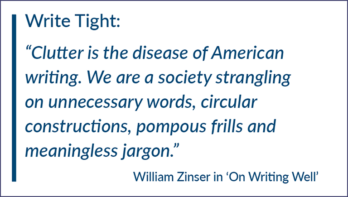Headlines may be the most important writing you’ll ever do. If your headline doesn’t work, the story may not even be read. Here are some tips for writing strong headlines. If the job of a lead sentence is to get your reader to go on to the next sentence, then the job of a headline is to get the reader to check our your lead. Headlines may be the most important writing in a publication — if the headline doesn’t catch the reader’s eye, the story doesn’t matter.
A good headline serves several purposes:
- It attracts reader attention
- It summarizes a story
- It helps the reader figure out what’s on the page
- It conveys the tone of the story
- It helps set an overall tone for your publication
- It provides typographic relief and is a factor in overall graphic balance.
Not every headline will do every one of these jobs, but that’s what you’re shooting for. A headline is a piece of sales copy — you’re selling your reader in the idea that they should read the story. One copy editor has suggested writing out your headline, then imaging yourself pushing into a party and shouting it out — you judge how good it is by how many heads would turn.
When you’re stuck on a headline, one place to start is with the “keyword method.” Figure out the words that need to be included to tell the reader what’s going on. Most good headlines have verbs, so start there, then add a subject and an object. That gives you three keywords for your headline — “Bush threatens China,” or “Flood strikes Fargo.” Subject-verb-object is the minimum, and once you have that you’re on your way to writing a headline.
When you’re choosing your keywords, pick words that are packed with information. “Man sustains a fatal injury” isn’t as good as “Guard killed in gun fight.” The latter headline gives the reader more information in the same space.
Here are some rules for writing better headlines:
- Rule #1 — Feel free to break these rules, if the result is a better headline
- Be sure to include a verb — your headline needs an action word
- Don’t split ideas from one line to the next (“Women need to / take calcium pills / report shows” is not as good as “Women require / more calcium / study reveals”)
- You can use a comma in place of “and,” as in: “Russia, China agree to talks”
- Emphasize the positive unless the story demands the negative. So it’s not “No concert due to ice storm.” It’s “Ice storm cancels concert.” Emphasize the action.
- Remember rules of grammar and follow them
- Eliminate most adjectives, adverbs and articles
- Don’t use “is” and “are” in a headline
- Don’t abbreviate more than you have to. Abbreviations clutter a headline, and make the reader stop to decode your meaning.
- Use short, simple words
- Don’t exaggerate
- Make the headline a complete sentence, not a fragment (you can imply the verb “is”)
- Phrase your headline in present tense when possible — this is called the “historical present”
- Don’t use a person’s name at the start of your headline — what they said or did is more important. And don’t use a name at all unless most of your readers will recognize it.
- Use only single quotation marks in headlines and other display copy.
- Use proper punctuation — a headline is a sentence
- Don’t repeat words
- Watch out for libel — a headline can be libelous even if the story isn’t. “Doctor kills child” isn’t right unless malpractice leading to death has been proven in court.
- Don’t capitalize anything except the first words and proper nouns. It saves space and is easier to read.
- Read the story at least twice before writing the headline. On the second read-through, be looking only for headline ideas
- Watch out for double meanings. “Pope to be arraigned for allegedly burglarizing clinic” makes sense if you know that the perpetrator’s last name is “Pope,” but for most readers it carries an unintended meeting.
- Take headline information from lead paragraphs, but don’t directly parrot a lead — paraphrase.
- If the story has a surprise ending, don’t give it away in the headline.
- Grab your reader’s interest
- Capture the flavor of the story
- Be sure to answer the “What’s in it for me?” question. If something in the story is directly relevant to the lives of your readers, make sure that’s clear from the headline.
- Remember that even though you’ve read the story, your readers haven’t. The headline needs to stand on its own, and not assume knowledge of material in the story.
- In multi-line headlines, don’t put conjunctions, verbs, prepositions or modifiers at the end of a line.
Of course, a feature headline or a lighthearted story gives you more license for creativity. Puns, cultural references, rhymes, alliteration — give your imagination free rein. But remember, in the end your goal is to communicate one simple thing to your reader: Here is why you should read this story.





